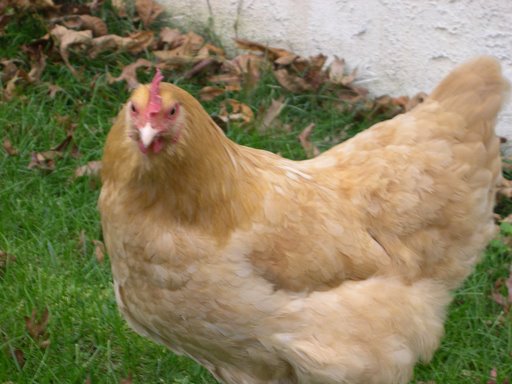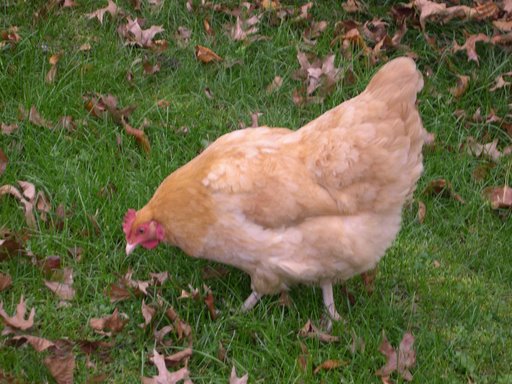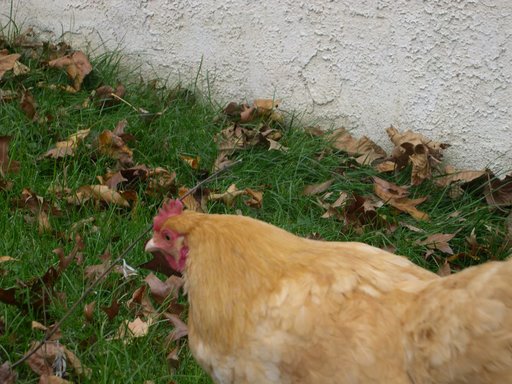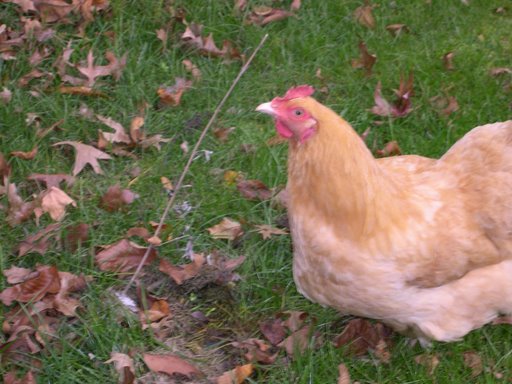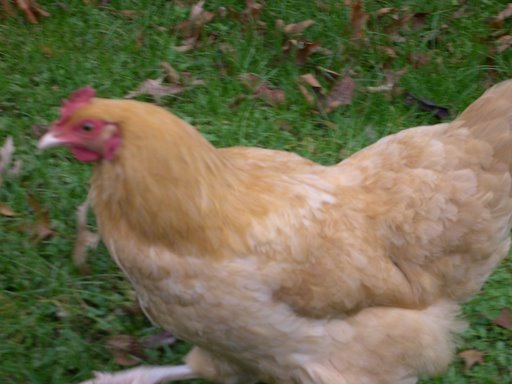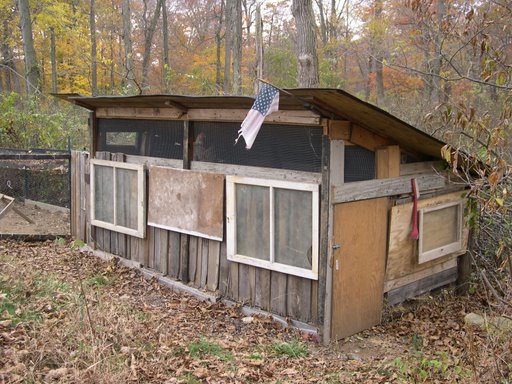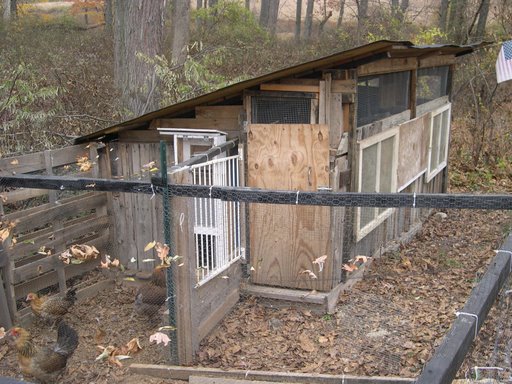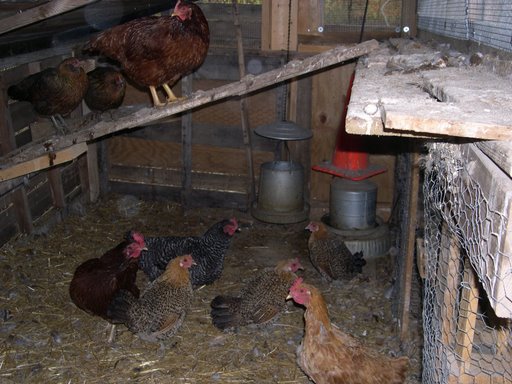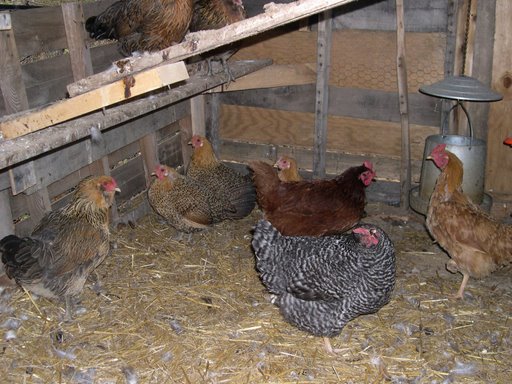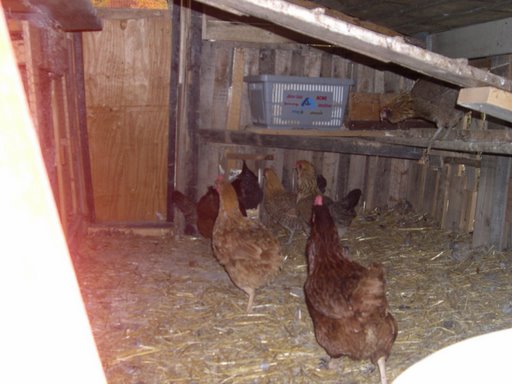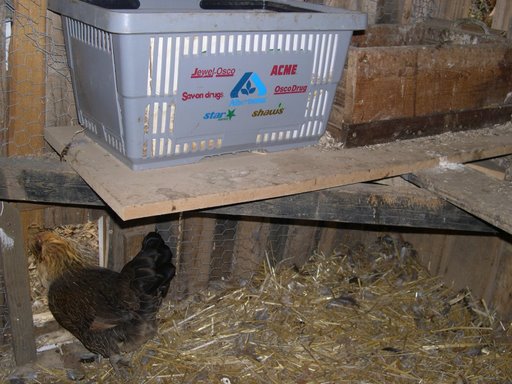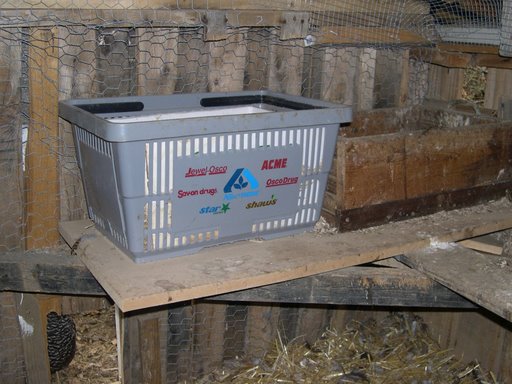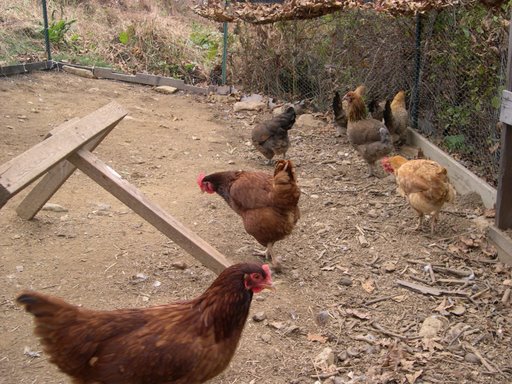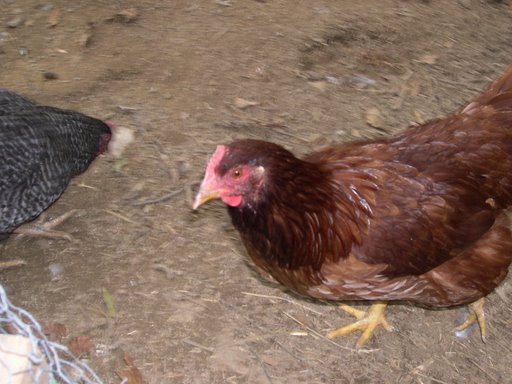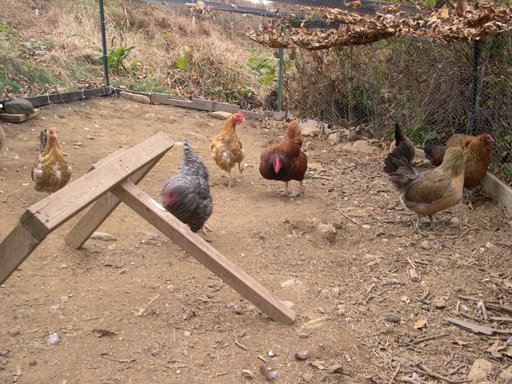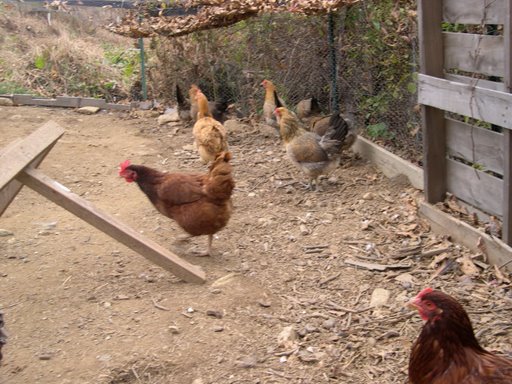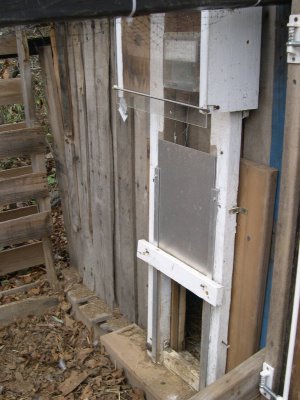
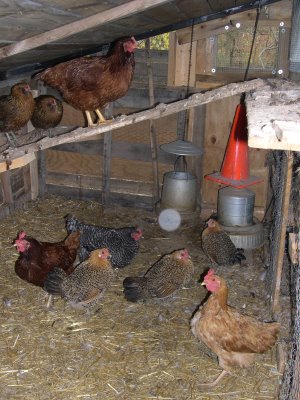
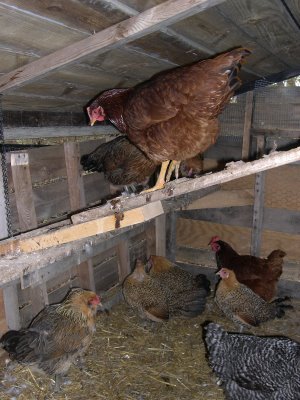
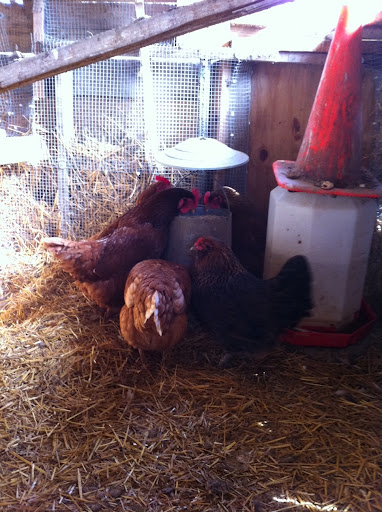
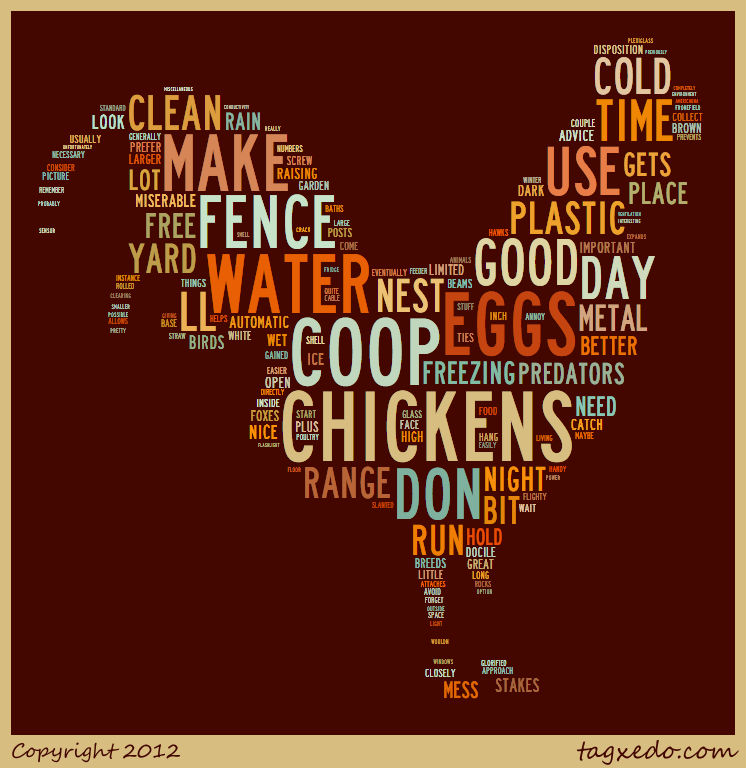
Here is some advice about raising chickens in a suburban environment and some important elements to include when making a chicken coop. I gained this wisdom through much trial and error, so maybe it will help someone else avoid some of the common pitfalls experienced by this novice chicken owner. There is no particular order to this.
First, there are three ways in which you can keep chickens:
Advantages: It's fun and you get to see the chickens run all around. They also eat healthy stuff (and bugs) in the yard.
Disadvantages: The mess (droppings plus scratched up plants/grass/yard) is not contained, and the droppings can end up in places like your driveway. They are vulnerable to predators during the day (particularly foxes and hawks). They can wander into your neighbor's yard and annoy them with droppings and damaging the yard.
You can make up a fence (see fence section below) which will contain them.
Advantages: You still get the free range aspect without a big risk of having them run around all over (though this can still happen if your fence isn't super high).
Disadvantages: Still susceptible to predators (foxes and hawks) during the day. Fence can be a bit ugly unless a lot of effort is made to make it look nice. Fence supplies can add up in cost. Whatever land you put within the fence will be destroyed eventually by the chickens, so consider it a barren wasteland.
The predator problem can be alleviated with a covered fenced-in run.
Advantages: Safety. No worries about chickens roaming into neighbor's yard. Easier to handle larger numbers of birds without making a neighborhood spectacle of yourself chasing after your chickens all the time.
Disadvantages: No free range diet, dirt baths, etc. In short, not as much fun for chickens and for you to watch.
You can usually gauge when the chickens are miserable and when they are content. If they are miserable (from being too wet or cold, for instance), consider changing these things to make them a little happier.
Chickens need a bit of space or else they will peck each other, and this can be quite gruesome if left to continue. Don't stack them up too closely for this reason, plus they'll be miserable.
Make doors with latches (deadbolts are what I use). Raccoons and other clever animals can defeat simple locks.
Ideally, your coop should be large enough to house the birds and their food and water, which is better kept inside the coop if you can manage it. A hanging feeder is best so they don't step in the food and make a mess. A water font is best since it prevents the same messiness as with the feeder and stores a lot of water. Try to make each of these available at the height of the chicken's back so they don't climb on it and make droppings in it. I hang an orange rubber cone directly over the water font so that they don't hop on it to roost (and make a droppings mess in their water).
The coop should have plenty of roosting space (a roosting bar or two) for all birds since that is where they like to sleep (on such bars). An inch width or a bit wider is fine for this. Keep it away from the food and water.
Some ventilation is nice, but if it gets cold in the winter, remember that they'll need a tarp or wooden board or some such thing to prevent freezing wind from blowing through.
Make the roof slanted to that snow and rain will roll off and not accumulate, which can ruin the roof (makes it rot and leak). Even a small slant will do, just not flat.
If your coop is more like chicken house (not just a glorified box), try to get some straw or pine shavings for the floor. It'll smell better and be much easier to clean when the time comes.
Try to keep the coop dry, so make the roof extend beyond the wall of the coop a bit so the rain doesn't drip into the coop. A good roof material to use is tar paper (essentially a big shingle which can be rolled out on the roof). It is good in weather, easy to install, and not too expensive. If your coop gets significantly wet inside, your chickens will be miserable plus it makes the coop a real hassle to clean and makes it reek. A dry coop won't smell too bad, so that's one way to can tell if it is getting too dirty and wet.
A chicken may lay as much as one egg a day. They'll consistently lay in the same place once they get the hang of it in a day or two. These eggs can accumulate for a couple of days, but don't wait too long or else the eggs might go bad, especially if it is very hot. If it is extremely cold, the eggs will freeze, expand, and crack the shell. If you have enough room in the coop so as not to overcrowd the chickens, the eggs should be pretty much totally clean when you collect them from the nest. If clean, take them directly to fridge (don't wash). Why? Because the egg shells are covered with an antibacterial layer when they are laid which helps keep them fresh. If there is mess on the shell when you collect the egg, wash the egg and scrub with an abrasive plastic brush until clean. Then take immediately to the fridge.
For a free range chicken, the chicken will probably find some place in the yard to start laying, so you'll have to track down the nesting place as an egg hunt.
I recommend giving eggs to your neighbors as often as possible. It is important to be a good neighborhood citizen when you have chickens in your yard.
How about an automatic door?
This option is expensive but very handy, especially if you plan to have your chickens outside for any length of time. It basically frees you from having to open the coop door in the morning and close it up at night. I have used the VSB automatic door with light sensitive opener (opens at dawn, closes at dusk). It works great and hasn't run out of battery power in a couple of years. I built a little wooden roof over the sensor piece so it wouldn't get rained on, and I added a plexiglass front cover over the sensor so rain and snow wouldn't get in there either.
If the chickens are outside during the day, the chickens will automatically come home to the coop to roost for the night when it gets dark. So you won't have to track them down and catch them every night. It might be a good idea to keep them inside the coop for a couple of days if possible or manually put them into the coop if they don't get the picture on the first few nights until they realize that this is home. They may start roosting in the trees when they first start living in the coop.
If you need to catch a chicken and get it into the coop at night, it is better to wait until it is dark out. While it is light, the chicken will run around and away from you and can be quite difficult to catch (unless it is used to being held a lot and then is easy to catch and hold). Once it is dark, it won't run around but will sit there hoping it won't be seen. You can approach the chicken with a flashlight quietly and it will stare at you while you shine it in its face. Then when you are ready to get hold of it, make the grab fast and tight (secure). It'll freak out when you grab it, but just hold tight for a second and it will pass. Then you can put the chicken in the coop.
One other important item concerning cold weather: frozen water. The water in the waterer will freeze into a block of ice when it drops below freezing. One solution to this is to get a heated base for metal water heaters. This is essentially an upside-down metal pan with a cord that plugs into a standard socket. Place the metal waterer on top of the base and it will keep the water unfrozen. Unfortunately, you have run an extension cord out to the coop to provide power during the winter months. This kind of heater works great, but a a metal waterer if preferred owing to its better thermal conductivity. I have used both plastic and metal, and the plastic container does have iced-over water in the trough if it gets very cold, but not enough to keep the chickens from having any water at all. The metal never has these issues. More evidence that a plastic waterer will work is seen in pictures taken by chicken expert Terry Golson of her coop which shows a plastic waterer on top of what appears to be the heater. If, on the other hand, you have a smaller waterer and want use a canning jar with a screw-on plastic base (and forget the heater), be sure not to use a glass jar (use a plastic one instead). The glass will crack when the water freezes and expands, and then you have shards of glass in your coop.
Chickens like to take a dirt bath from time to time and are happiest doing so (this argues for the limited or free range model).
